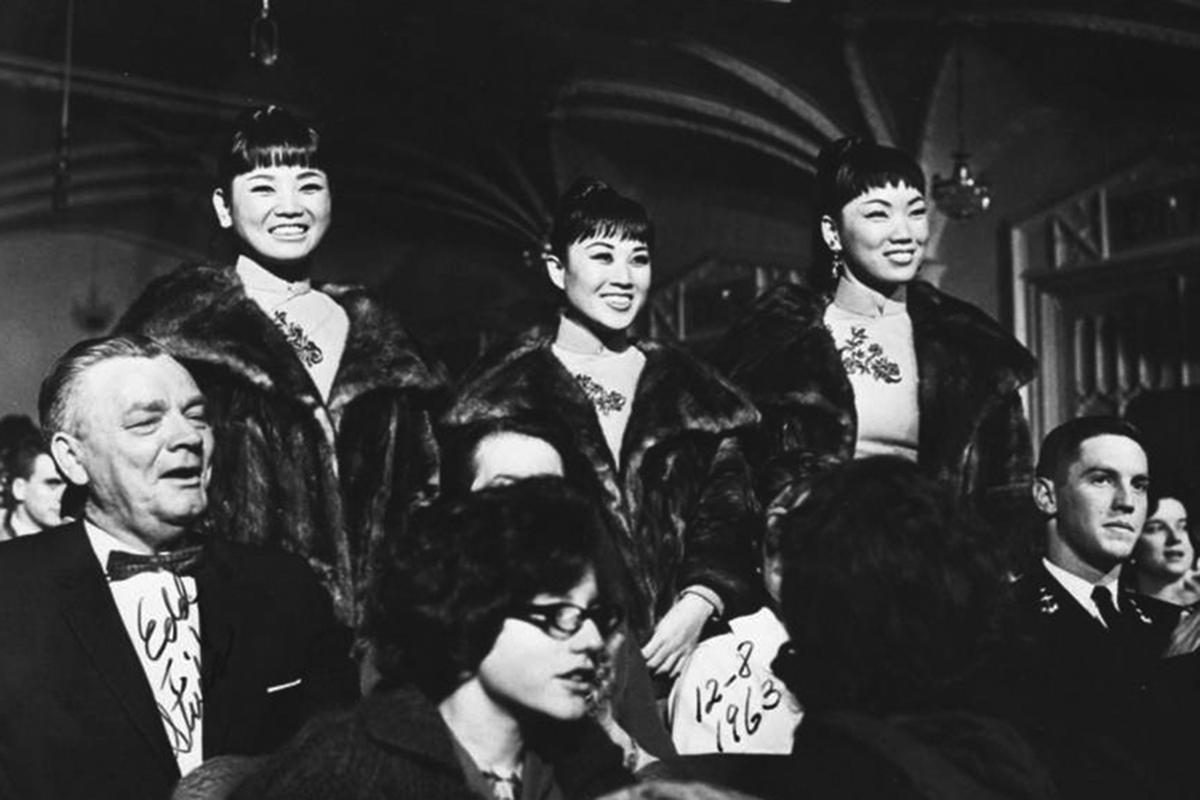
by Danielle Seid, PhD candidate, Department of English
Over winter break, I had a chance to speak with lifelong entertainer Sue Kim, one of three sisters in the musical girl group the Kim Sisters. A few years after the Korean War, in 1959, the group—Sue, Mia, and Ai-Ja— arrived in the United States as “cultural ambassadors” from the Republic of Korea. They were immediately booked on the highest-rated television variety shows at the time, most prominently The Ed Sullivan Show (1948-1971). The Kims’ performances on 1960s American television, along with their experiences as Asian American entertainers, offer us insight into shifting racial dynamics within the postwar United States, as well as the violence and fascination frequently visited upon Asian American women’s bodies.
Historically, Asian American performers in Hollywood and other popular entertainment industries have struggled against typecasting, discrimination, erasure, and various forms of abuse. Studying histories of Asian American performers in popular entertainment industries helps us not only to understand the always already gendered and sexualized labor conditions and challenges Asian American performers have endured, but also the complicated relationship between Asian Americans and the U.S. nation.
Over the last year, my research evolved from an interdisciplinary project exploring issues of Asian American gendered and sexual labor in literature and film to a medium-specific examination of representations of and performances by Asian American women on American network television. My choice to focus on television was largely motivated by the fact that in scholarship on popular visual culture, film has generally been privileged over television as a site for the study of racial representation. Moreover, as a medium marked by its domestic and “feminized” qualities, television offers us intimate access to the historical construction of raced and gendered bodies in the nation.
I build my case studies around what I call the “Asian/American femme,” an evolving, and yet static, figure on American television since the early 1950s. The performers I explore all appeared on television from 1950 to 1995. I situate the Asian/American femme in my project in relation to moments of national crisis, such as Chinese exclusion and the U.S. cold war military “interventions” in the Korean and Vietnam Wars. I argue that at different historical moments since the 1950s, the figure of the Asian/American femme on television has been used to naturalize and justify the expansion of American empire.
The presence of the Asian/American femme body on American television screens, however, also disrupts the logic of racial progress within the nation and poses a challenge to the image of a “benevolent” U.S. military and economic presence abroad. I demonstrate this by detailing how the Asian/American femme reveals the gendered racialization at the core of Western imperialism and how Asian/American femme performers unsettle familiar historical narratives about the nation.
To research earlier moments in television history, especially given the scant attention given to nonwhite performers in television studies, I have employed diverse methods of historical recovery and investigation that combine rare television footage, press materials, photographs, fan magazines, and personal interviews. Early on in my research, a CSWS research support grant allowed me to develop my research agenda, methods, and timeline for a project that hinges on working with archives marked by enormous gaps.
In December, I traveled to Las Vegas where I did research at the University of Nevada at Las Vegas Center for Gaming Research as a William R. Eadington fellow. UNLV’s Special Collections houses materials that document the career and performance history of the Kim Sisters. My research began with the Kim Sisters’ scrapbooks, which were full of photos and press clippings that describe the girls’ early years performing for American GIs stationed in Korea, their arrival in the United States via the Las Vegas showroom scene, and their successful career as glamorous television entertainers. In addition to the press materials and photos, I used a transcribed oral history with Sue to help construct this largely forgotten part of television history. Sue also graciously spoke with me from her Las Vegas home about her life as a professional entertainer.
Drawing from scholarship in Asian American studies on U.S. cold war logics and Asian American cultural production, my work investigates what the Kim Sisters’ performance history reveals about postwar Asian-American cultural and legal citizenship, as well as U.S. military and economic imperialist expansion in Asia and the Pacific. Focusing on the role of beauty, sexuality, and feminine ideals in the construction of the Kim Sisters’ image, I detail how American audiences were invited to see and experience the young femmes as both “adopted family” and sexy “Oriental vixens.” In March, I presented my research on the Kim Sisters, titled “Forgotten Femmes, Forgotten War: The Kim Sisters’ Disappearance from American Television,” at the annual Society for Cinema and Media Studies conference in Atlanta, Georgia. Currently, I am revising my essay on the Kim Sisters for a special issue of a journal on global fashion, media, and consumption.
In subsequent chapters of my dissertation project, I explore the television career of the famous Chinese-American film actress Anna May Wong in the 1950s and the proliferation of minor Asian-American femme characters—played by actresses such as Tia Carrere, Ming-Na Wen, and Mia Korf—on daytime soaps in the 1980s and early ’90s. Across my project, I interrogate how television has profoundly shaped our perception of the nation and empire via representations of race, gender, and sexuality. My ultimate goal is to help develop strategies and vocabularies for reading television history critically in spite of its significant gendered and racialized erasures and absences.
—Danielle Seid is a graduate teaching fellow in the Department of English, where she teaches history of the motion picture.

